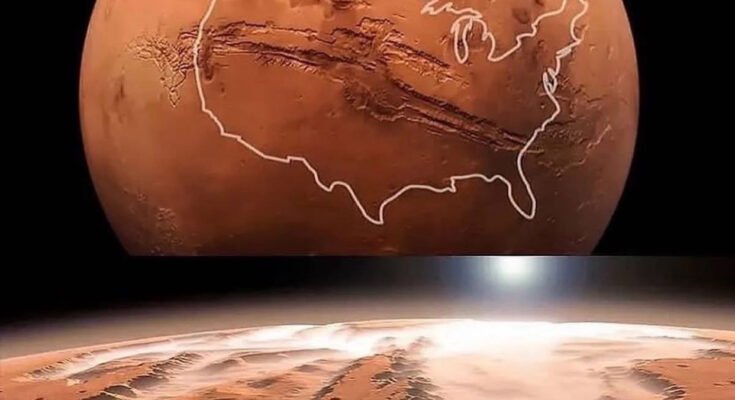Mars has always fascinated scientists and stargazers alike, but one of its most jaw-dropping features is something many people have never even heard of. Deep beneath its dusty red skies lies a geological wonder that puts even the Grand Canyon to shame. This is Valles Marineris — the longest, deepest canyon in the entire solar system. If this Martian marvel existed on Earth, it would stretch all the way across the continental United States, from coast to coast. That’s right — it would span over 2,500 miles, cutting across the country like a scar from New York to California.
To put its scale into perspective, imagine a canyon over ten times longer and nearly four times deeper than the Grand Canyon in Arizona. Valles Marineris plunges as deep as seven miles in places, with cliffs so steep and expansive that they would tower over any skyscraper on Earth. Its width is just as impressive, sometimes extending over 120 miles from rim to rim. It’s not just a single canyon, but a complex system of interconnected valleys, trenches, and chasms that appear to have been carved out by colossal forces — forces that scientists are still trying to fully understand.
Unlike Earth’s canyons, which are often formed over millions of years by the persistent flow of water, Valles Marineris likely has a more dramatic and violent origin story. Mars doesn’t currently have flowing rivers or oceans like Earth, so its canyon systems weren’t shaped by erosion in the traditional sense. Instead, many researchers believe that Valles Marineris was born from tectonic activity. When the Martian crust began to stretch and crack due to internal geological forces, massive rifts formed, pulling the ground apart and creating the initial scars that would evolve into this extraordinary canyon. Some theories even suggest that volcanic activity from a nearby region called the Tharsis Plateau played a role. The immense weight of giant volcanoes like Olympus Mons could have caused the crust to buckle and fracture, leading to the creation of this sprawling canyon network.
What’s even more intriguing is the evidence that water may have once flowed through parts of Valles Marineris. Ancient riverbeds, mineral deposits, and signs of erosion hint that this alien landscape may have once hosted conditions suitable for life. If that turns out to be true, the canyon may not only be a geological treasure, but also a key location in the search for past microbial life on Mars. Future missions may one day explore its shadowy depths, searching for clues about the Red Planet’s mysterious past — and perhaps even hints of its potential to support life again.
In a way, Valles Marineris serves as a monument to the raw, untamed forces that shape planets. While Earth has its own natural wonders — the Rocky Mountains, the Grand Canyon, the Mississippi River — Mars offers us a glimpse at geological extremes on an entirely different scale. Valles Marineris reminds us that our neighboring planet is far from a dull, lifeless desert. It’s a place of epic landscapes and ancient secrets, just waiting to be uncovered.
If we ever manage to send humans to Mars, Valles Marineris will undoubtedly be one of the most captivating destinations. Imagine standing at the edge of a canyon so wide that its far side disappears into the rusty haze, its cliffs plunging downward farther than any place on Earth. The silence would be deafening, the view otherworldly. It’s a scene ripped straight from science fiction — except it’s real, and it’s out there, silently waiting.
As our technology advances and our dreams of space exploration grow bolder, Valles Marineris stands as a symbol of the wonders that await us beyond our world. It’s a cosmic reminder that even in our own solar system, there are places so vast, so alien, and so awe-inspiring that they stretch the limits of our imagination. While Earth is rich with beauty and diversity, Mars holds a promise of discovery — and Valles Marineris is at the heart of that promise.
So next time you look up at the night sky and catch a glimpse of that tiny red dot, remember that hiding within it is a canyon so enormous it would dwarf anything on our planet. A canyon that, if placed here, would split the nation from sea to shining sea. Mars may be 140 million miles away, but Valles Marineris brings its mystery a little closer to home.




